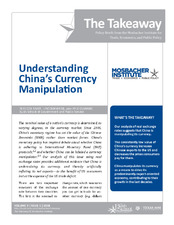| dc.creator | Skaff, Rebecca | |
| dc.creator | Webb, Lincoln | |
| dc.creator | Clahane, Kyle | |
| dc.date.accessioned | 2018-04-13T14:17:11Z | |
| dc.date.available | 2018-04-13T14:17:11Z | |
| dc.date.issued | 2018-03 | |
| dc.identifier.uri | https://hdl.handle.net/1969.1/166316 | |
| dc.description | Since 2005, China’s monetary regime has set the value of the Chinese Renminbi (RMB) rather than market forces. In this issue of The Takeaway three Bush School students use research from one of their classes to enter the debate about whether China can be labeled a currency manipulator. Their analysis examines real exchange rates looking for evidence that China is undervaluing its currency to artificially inflate its net exports—to the benefit of US consumers but at the expense of the US trade deficit. | en |
| dc.language.iso | en_US | |
| dc.publisher | Mosbacher Institute for Trade, Economics & Public Policy | |
| dc.relation.ispartofseries | Volume 9;Issue 1 | |
| dc.rights | Attribution-NonCommercial-NoDerivs 3.0 United States | en |
| dc.rights.uri | http://creativecommons.org/licenses/by-nc-nd/3.0/us/ | |
| dc.subject | real exchange rate | en |
| dc.subject | currency manipulation | en |
| dc.subject | Chinese Renminbi | en |
| dc.title | Understanding China's Currency Manipulation | en |
| dc.type | Article | en |
| dc.contributor.sponsor | Bush School of Government and Public Service | |



